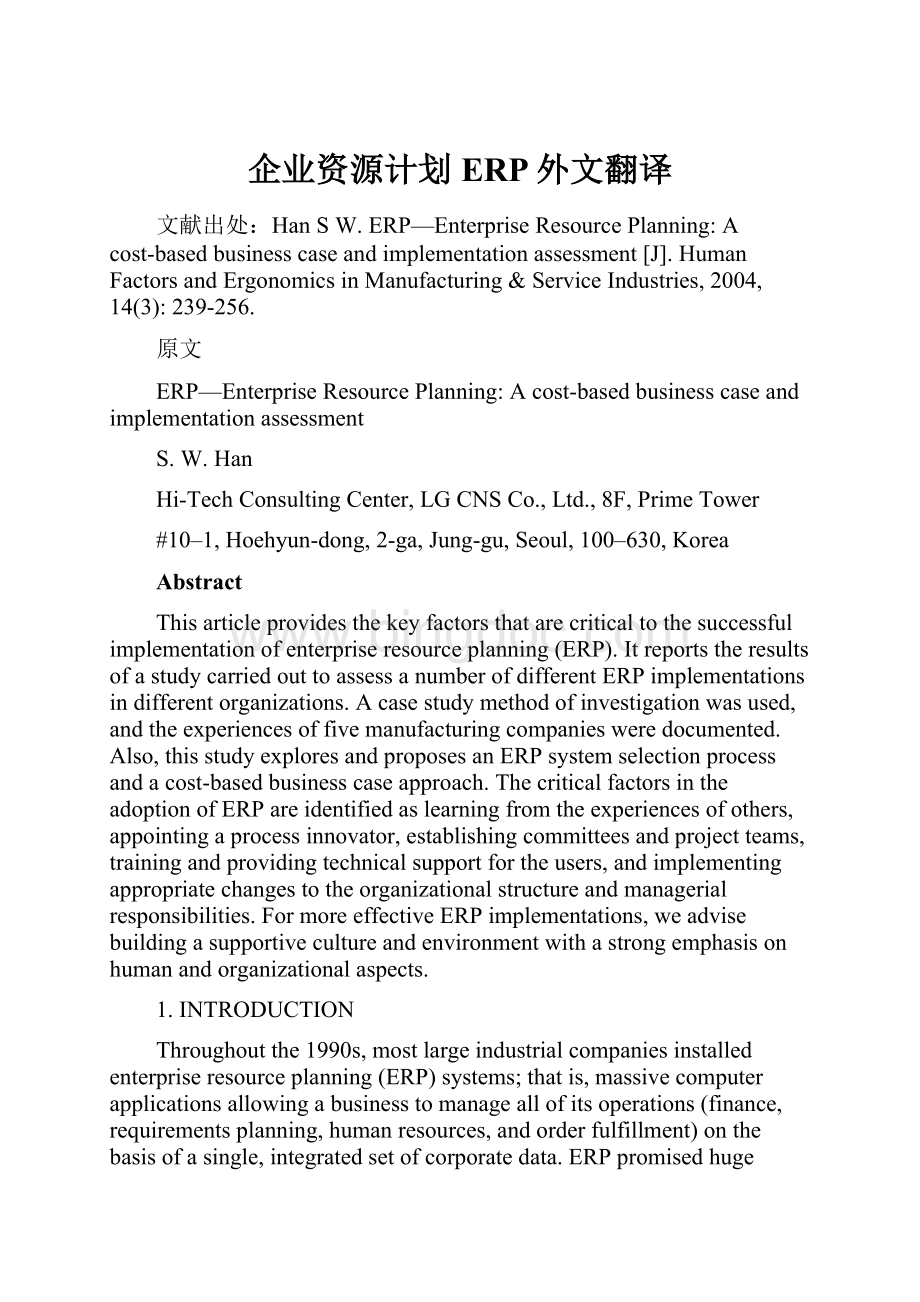企业资源计划ERP外文翻译.docx
《企业资源计划ERP外文翻译.docx》由会员分享,可在线阅读,更多相关《企业资源计划ERP外文翻译.docx(10页珍藏版)》请在冰点文库上搜索。

企业资源计划ERP外文翻译
文献出处:
HanSW.ERP—EnterpriseResourcePlanning:
Acost‐basedbusinesscaseandimplementationassessment[J].HumanFactorsandErgonomicsinManufacturing&ServiceIndustries,2004,14(3):
239-256.
原文
ERP—EnterpriseResourcePlanning:
Acost-basedbusinesscaseandimplementationassessment
S.W.Han
Hi-TechConsultingCenter,LGCNSCo.,Ltd.,8F,PrimeTower
#10–1,Hoehyun-dong,2-ga,Jung-gu,Seoul,100–630,Korea
Abstract
Thisarticleprovidesthekeyfactorsthatarecriticaltothesuccessfulimplementationofenterpriseresourceplanning(ERP).ItreportstheresultsofastudycarriedouttoassessanumberofdifferentERPimplementationsindifferentorganizations.Acasestudymethodofinvestigationwasused,andtheexperiencesoffivemanufacturingcompaniesweredocumented.Also,thisstudyexploresandproposesanERPsystemselectionprocessandacost-basedbusinesscaseapproach.ThecriticalfactorsintheadoptionofERPareidentifiedaslearningfromtheexperiencesofothers,appointingaprocessinnovator,establishingcommitteesandprojectteams,trainingandprovidingtechnicalsupportfortheusers,andimplementingappropriatechangestotheorganizationalstructureandmanagerialresponsibilities.FormoreeffectiveERPimplementations,weadvisebuildingasupportivecultureandenvironmentwithastrongemphasisonhumanandorganizationalaspects.
1.INTRODUCTION
Throughoutthe1990s,mostlargeindustrialcompaniesinstalledenterpriseresourceplanning(ERP)systems;thatis,massivecomputerapplicationsallowingabusinesstomanageallofitsoperations(finance,requirementsplanning,humanresources,andorderfulfillment)onthebasisofasingle,integratedsetofcorporatedata.ERPpromisedhugeimprovementsinefficiency;forexample,shorterintervalsbetweenorderandpayments,lowerback-officestaffrequirements,reducedinventory,andimprovedcustomerservice.Encouragedbythesepossibilities,businessesaroundtheworldinvestedsome$300billioninERPduringthedecade(Dorien&Malcolm,2000).
Whatmostattractedmanyachiefinformationofficerwastheopportunitytoreplaceatangleofcomplex,disparate,andobsolescentapplicationswithasingleY2K-compliantsystemfromareputableandstablevendor;oneKoreanmajoroilcompany,forexample,managedtoswitchoff70oldsystemswhenERPwentlive.ByenteringcustomerandsalesdatainanERPsystem,amanufacturercangeneratethenextcycle’sdemandforecast,whichinturngeneratesordersforrawmaterials,productionschedules,timetablesforshifts,andfinancialprojectionswhilekeepingclosetrackofinventory.
AstheadoptionofERPhasincreasedbymanufacturingfirms,sohastheresearchbyacademicsandresearchersintoallaspectsofusingtheseinformationtechnologies,coveringplanning,implementation,integration,management,andexploitation(Lee&Lee,2000;Parr&Shanks,2000;Sumner,2000).Someexamplesofthesestudiesinclude:
astudyofERPin20BritishcompaniesbyCurrie(1996),astudyof95informationsystemsbyJaikumar(1997)inNorthAmerica,andastudyofERPandotherinformationsystemsintheUnitedKingdombyBessantandHaywood(1999).
2.ERPSYSTEMSELECTIONPROCESS
ERPsystemsofferpervasivebusinessfunctionality.Becauseofthispervasiveness,implementationshaverangedfromgreatsuccessestocompletefailures.Therefore,adviceisfrequentlysoughtinselectingsystems.However,wehaveconcludedthatthereisnosystemthatisbestforallcompanies,butratherthereisaprocessyoucangothroughtofindtherightsystemforyourcompany.Theprocessstartswithassemblingacompetentprojectteam,addressingbusinessneeds,exploringalternatives,developingcriteria,andmakinginformedjudgmentsthatleadtoasuccessfulsystem.
3.ACOST-BASEDBUSINESSCASEAPPROACH
ManycompaniesfindERPsystemshelpthemmakebetter-informeddecisions.Othersdiscovertoolatethattheirpurchasehasbeenbasedmoreonfaiththangoodjudgment,andrunuptensorevenhundredsofmillionsofdollarsinextracostsandscheduledelays(Sethi&King,1994).How,then,canseniormanagersensurethattheircompaniesbuildasoundbusinesscasefordeployingERPsystems?
Andwhatcantheydotoguaranteethatthepromisedbenefitsarenoteclipsedbythecostsofintegration,processredesign,andtraining?
Oneansweristotakeacost-basedapproachtothebusinesscase.
Hardreturns,suchasreducedheadcountresultingfromstreamlinedoperations,aresimpletopredictandcontrolbutareonlypartofthepicture.Softreturns,suchasrevenueoremployeeproductivitygains,areneithereasytopredictnorunderacompany’sdirectcontrol(Gorry&Morton,1971).TheproblemisacommononeinevaluatingITinvestments(Dempsey,Dvorak,Holen,Mark,&Meehan,1998).
InthecaseofERPsystems,thelengthofthepaybackperiodandthesizeoftheinvestmentneeded—intermsofbothcashandhumanresources—makeitunwisetoassessaprojectonanythingbutahard-returnsbasis.ThisisnottosuggestthatanERPsystemcannothelpacompanyboostrevenue,orthatemployeescannotlearntobecomemoreproductivewiththeaidofasuperiormanagementinformationsystem.ButthedifficultyandexpenseofdeployingERPmeanthatmostcompaniesshouldappraisesuchaninvestmentpurelyintermsofitspotentialtocutcosts.
4.THEKEYFACTORSFORSUCCESSFULERPIMPLEMENTATION
4.1.OverviewofCaseStudy
Thefiveorganizationsinvolvedinthisstudywerechosenafterpreliminarydiscussionwiththecompanycontactconcerningtheaimsandobjectivesoftheresearchproject.Potentialcompaniesforparticipationinthestudywereinitiallyidentifiedthroughvarioussources;thatis,suggestionsbyfacultyandstaffmembers,existingongoingpersonalcontactswithlocalcompaniesmanagers,newcontactsmadewithcompanyrepresentativesparticipatinginconferencesandseminars,andpublicityofthecompany’snewlyacquiredinformationsysteminthemedia.
4.2.FieldInterviews
Basedontheauthor’spreviousresearchinERP(Park&Han,2002;Sohaletal.,2000)andtheliterature,aninterviewquestionnairewasdevelopedandusedinfieldinterviews.Theinterviewguide(questionnaire)focusestheinquiryproceduresandensuresreasonablyconsistentinquiryproceduresatallsites(Gosse,1993).Severalvisitsweremadetoeachcompany.Duringtheinitialmeetingwithseniormanagement(typicallythemanagingdirector,generalmanager,orplanmanager),theaimsandobjectivesoftheresearchprojectweredescribedanddiscussedinsomedetail.Discussionwithseniormanagementfocusedonissuessuchastheoverallstrategyoftheorganization,thebasisofcompetitiveadvantage,competition,thecompany’sperformanceinrelationtothedimensionsofcompetitiveness,reasonsforimplementingtheparticularinformationsystem,theirroleinplanningandimplementationoftheinformationsystem,andthebenefitoftheinformationsystemtotheorganization.
4.3.ResultandSummary
Thetapedinterviewsweretranscribedandwrittenupintheformofcasestudies.Thisprocesstookaconsiderableamountoftimeaseachcasestudywentthroughanumberofdrafts,sometimesgoingbacktothecompaniesforfurtherdetailsorreplayingthetapedinterviews.Thecasestudieswerethensenttothecompanycontactforverificationandpermissionforgeneraluseinpublications.
Thewrittencasestudieswerethenusedtounderstandthefollowing:
Competitiveprioritiesandcompanygoals;
Reasonsforadoptingthenewinformationsystem;
Planningandimplementationprocedures/issues;
BenefitsachievedfromtheERPinvestment;
ThedifficultiesandlimitationsassociatedwithadoptingtheERP.
Theresultsofthisanalysisarepresentedbelowundereachoftheaboveheadings.
5.LIMITATIONSOFTHESTUDY
ThisstudyisthefirstattempttodiscussanddescribeexperiencesofERPimplementationinKorea.ThefindingsandresultsarepracticalratherthantheoreticalbecausetheparticipantsofthesurveyareactuallyERPusers.Inspiteofthisstrength,thestudyhasweaknesses.Somelimitationsoriginatedfromtheapproachofourresearch.First,wehadtorelyontheretrospectiveexperiencesoftherespondents.Itmaybearguedthatrespondentviewsmightbebiased.Second,oursamplesarelimitedtoKorea.Therefore,generalconclusionsmustbemadewithcaution.Additionally,theimplementationofERPinKoreahasthebarriersinherentintheprocessoftechnologytransferbecauseERPinKoreacomesprimarilyfromdevelopedcountries.TheliteratureontheimplementationofERPhasbeenwritteninthecontextofdevelopedcountries,primarilytheUnitedStatesandEurope.Thefindingsofthisstudy,togetherwithotherstudiesfromdevelopedcountries,showthathumanandorganizationalfactorsplayacentralroleintheERPimplementation.However,ERPisnolongerrestrictedwithincountries,becauseofglobalization.Therefore,thefindingsofthisstudycanbemorethananindicatorofothercountriesaswell.
6.CONCLUSIONS
ThisstudyexploresandproposesanERPsystemselectionprocessandacost-basedbusinesscaseapproach.BeforeselectinganERPsystem,abusinessmustfirstlookatitselfandunderstanditssubstance,askingtwoveryfundamentalquestions:
“Whatarewe?
”and“Whatdowewanttobe?
”ThetypicalstepsofERPselectioninvolveplanning,analysis,vendorscreening,in-depthevaluation,anddecisionfinalization.Incontrasttoothersoftwareselections,acomprehensiveERPselectionismademorecomplexbythescopeofapplicationfunctionality,changeimpact,size,andintegrationrequirements.Mostorganizationsstruggletocommitacoreteamoffull-timeresourcestotheproject.Ourexperience